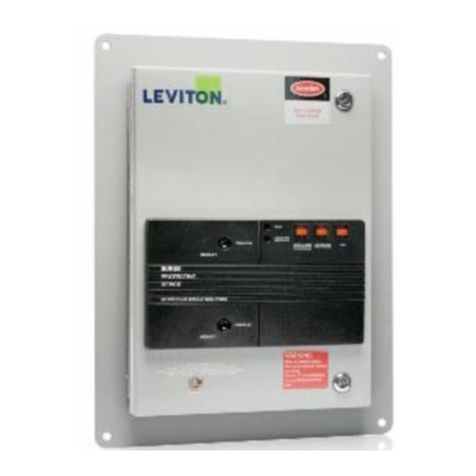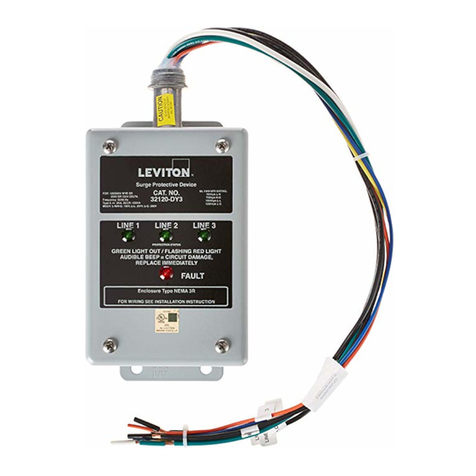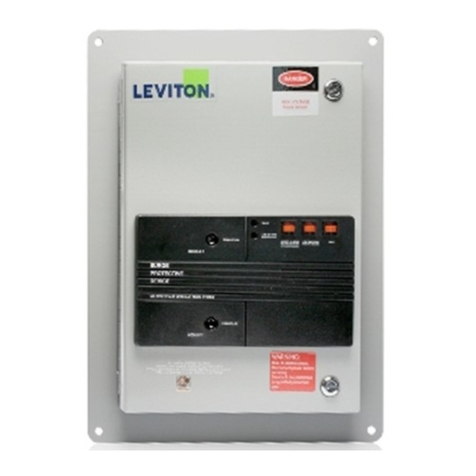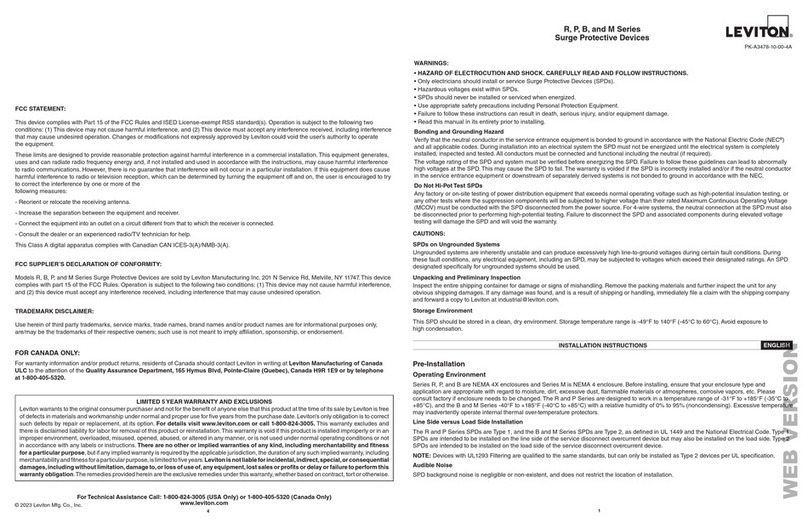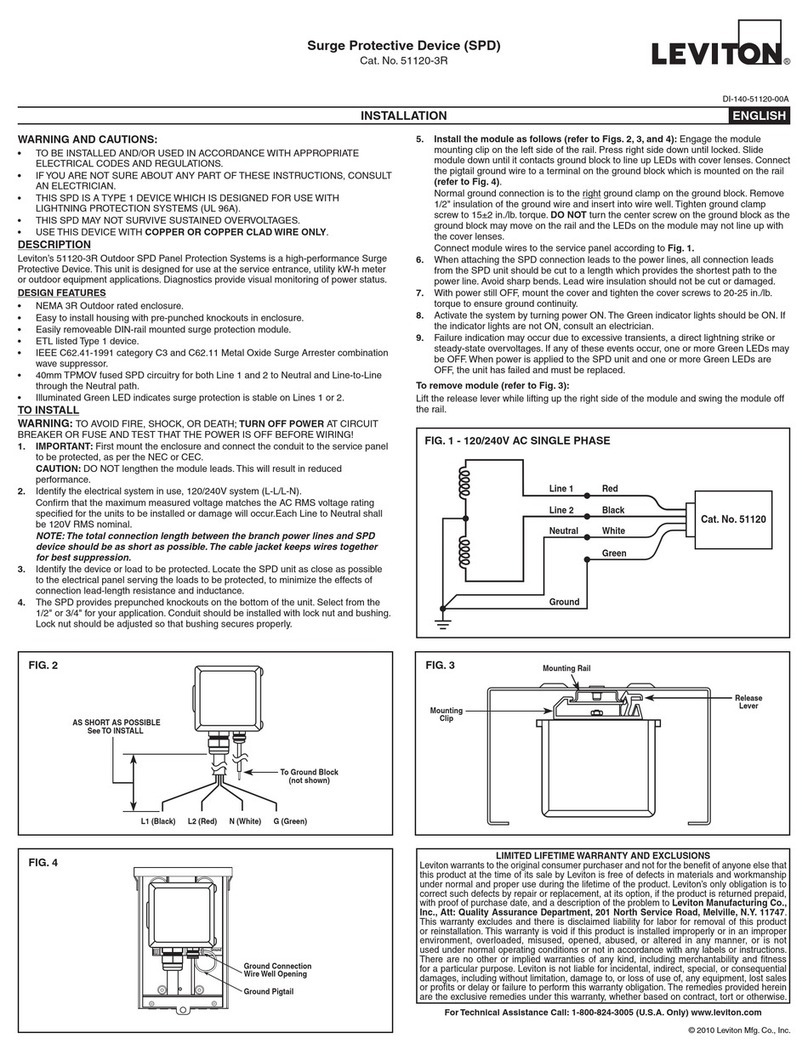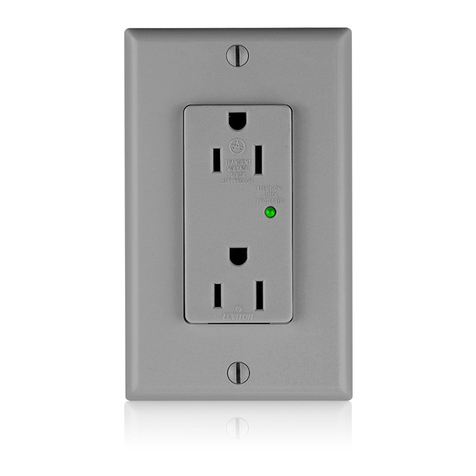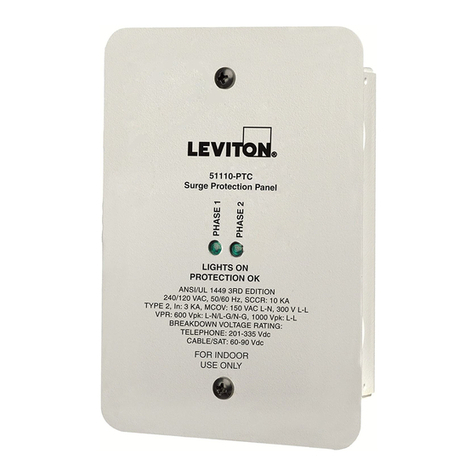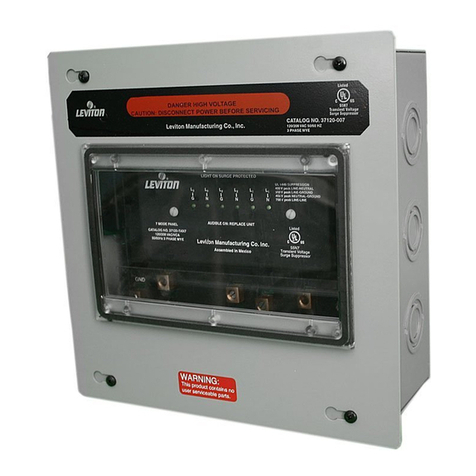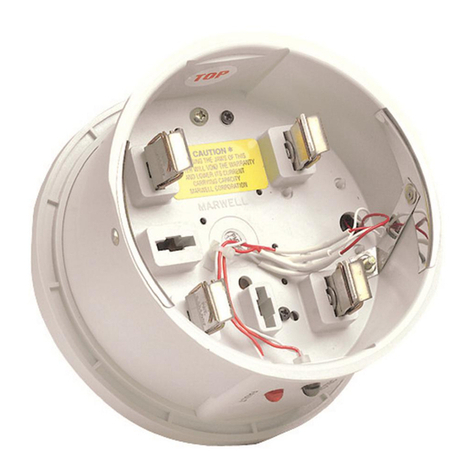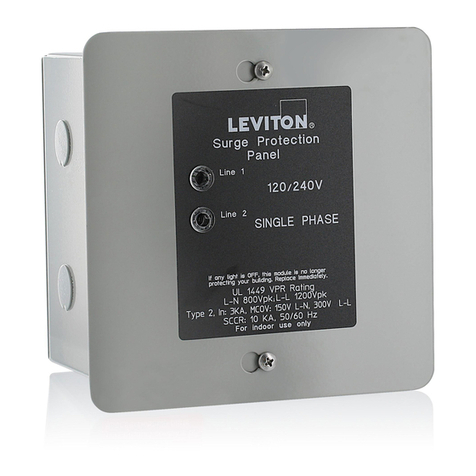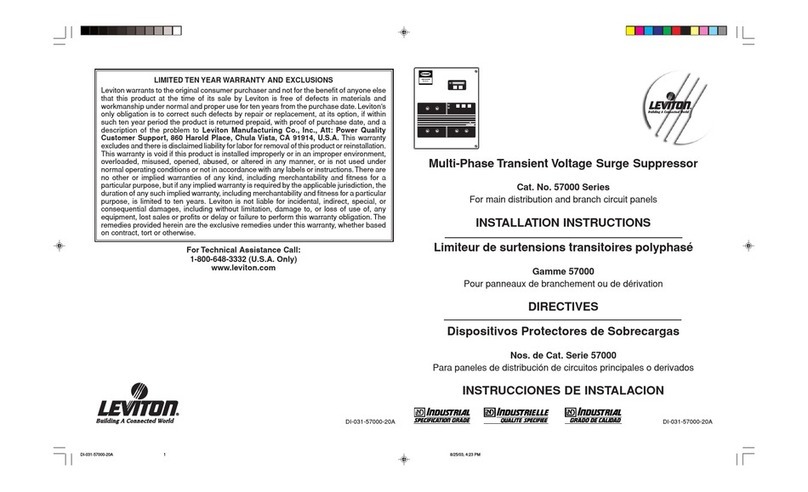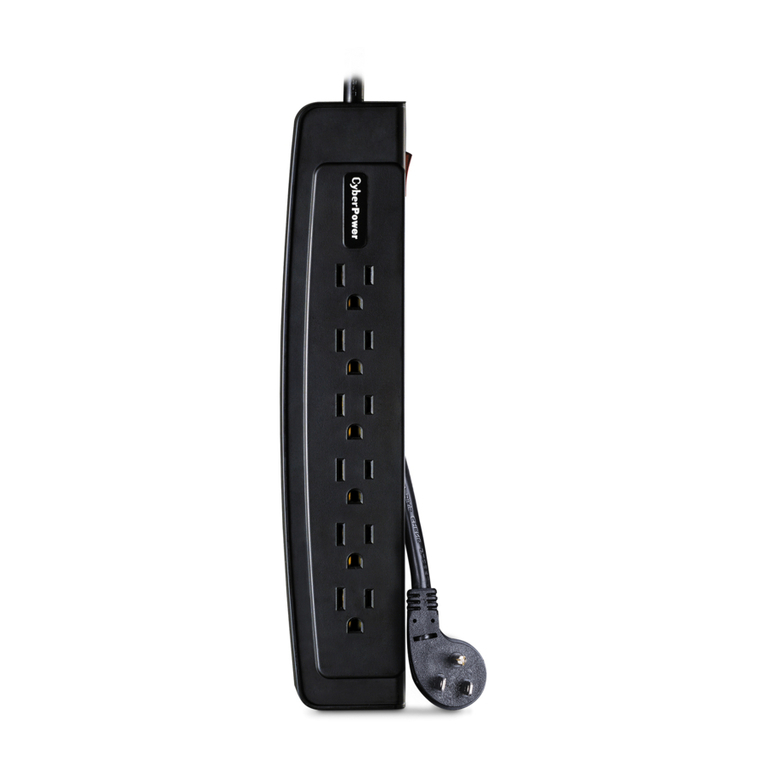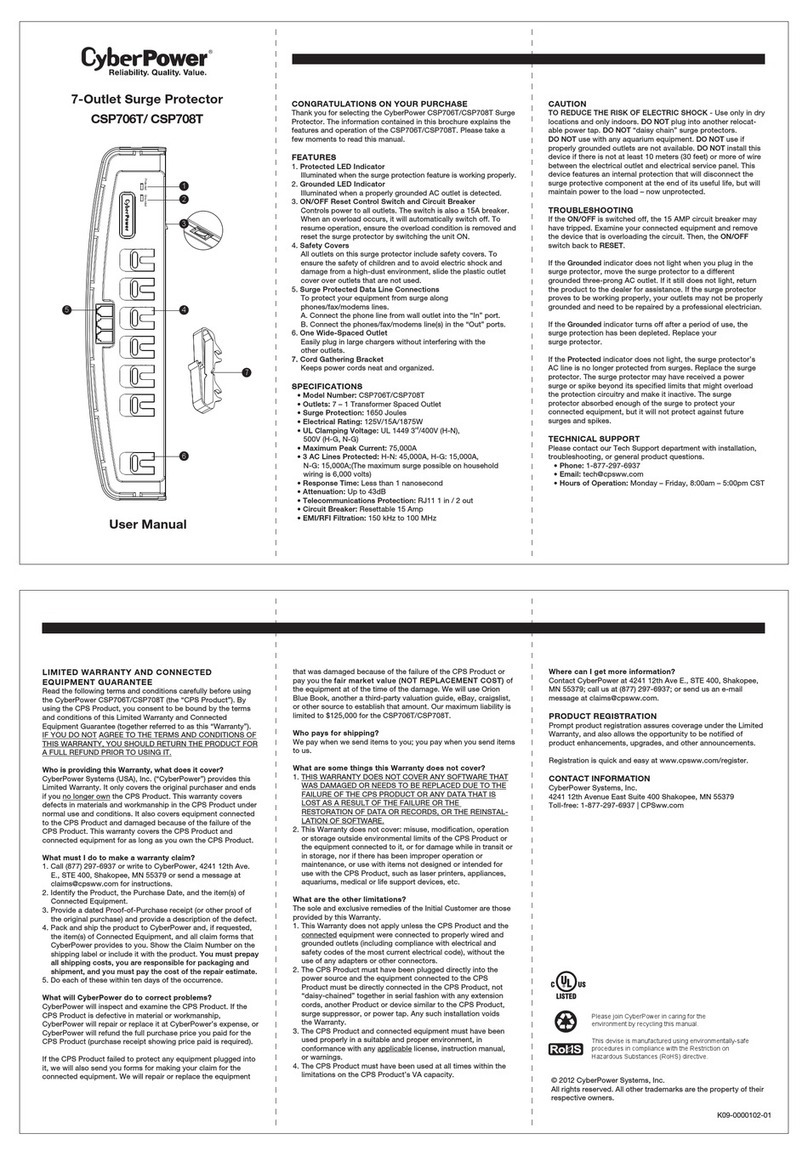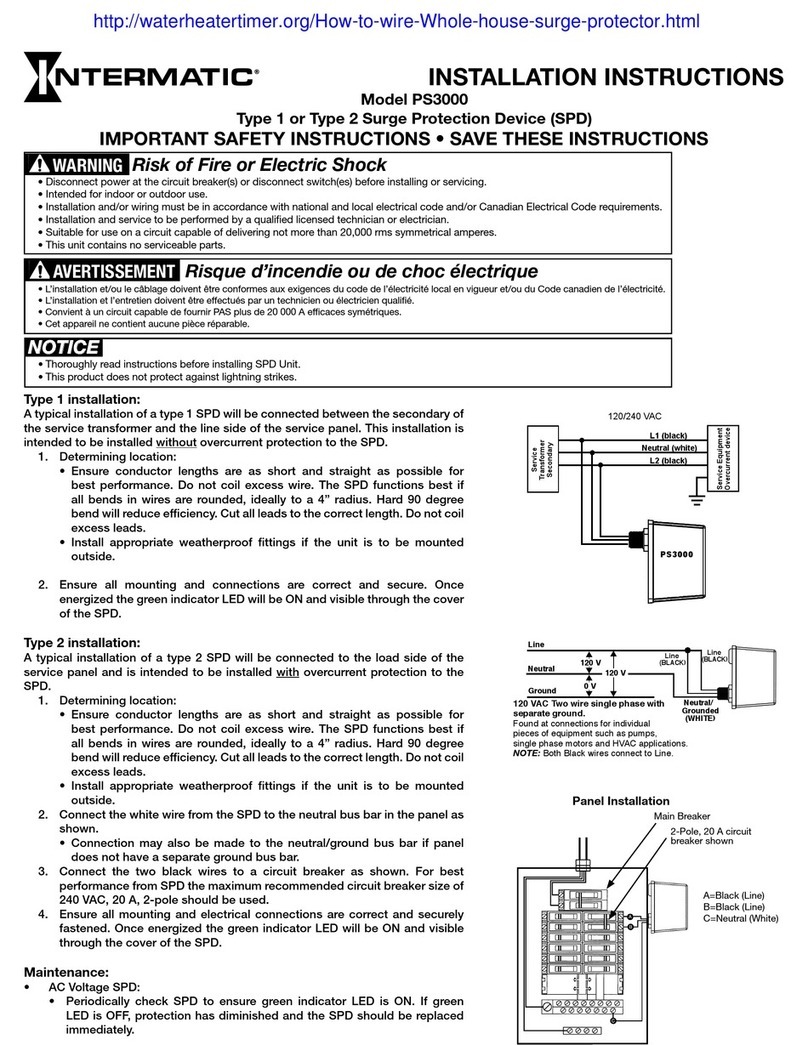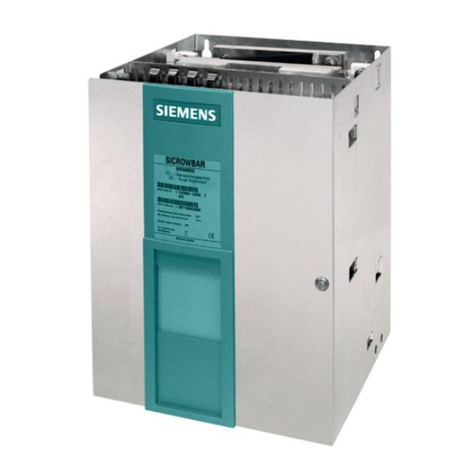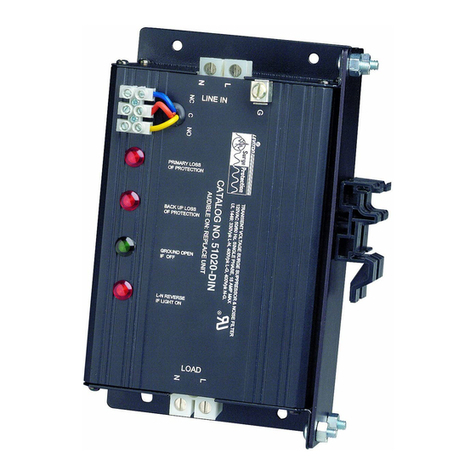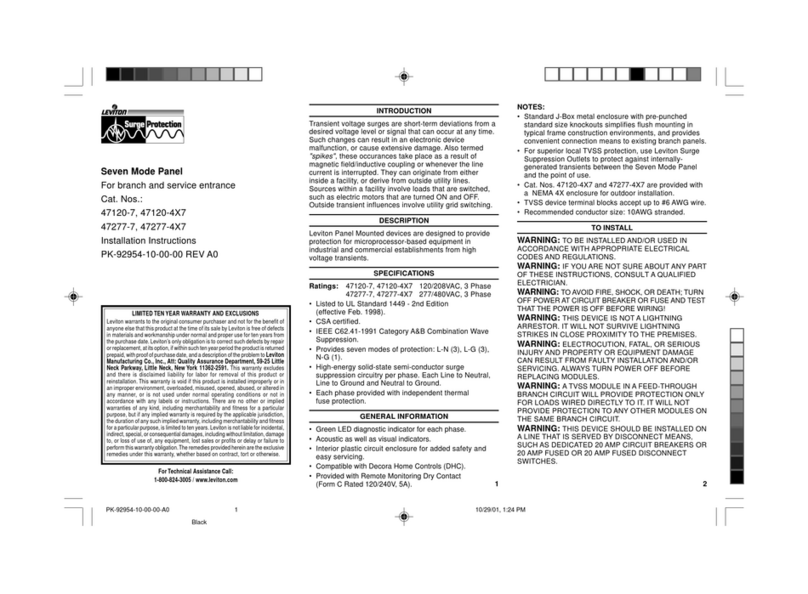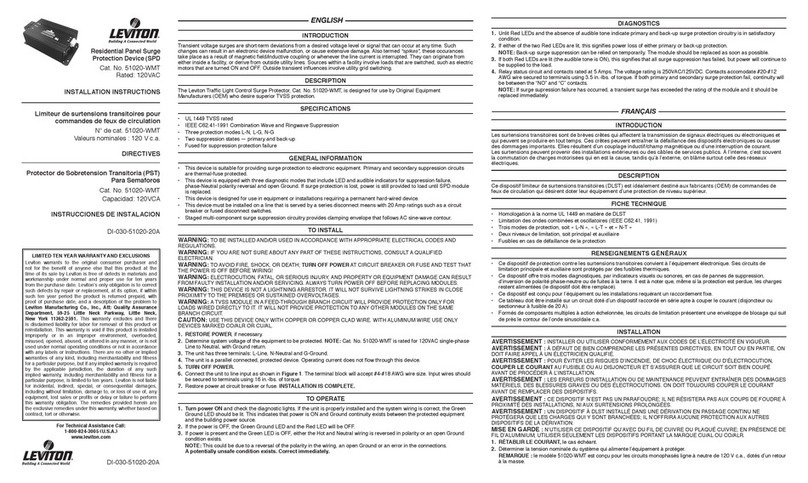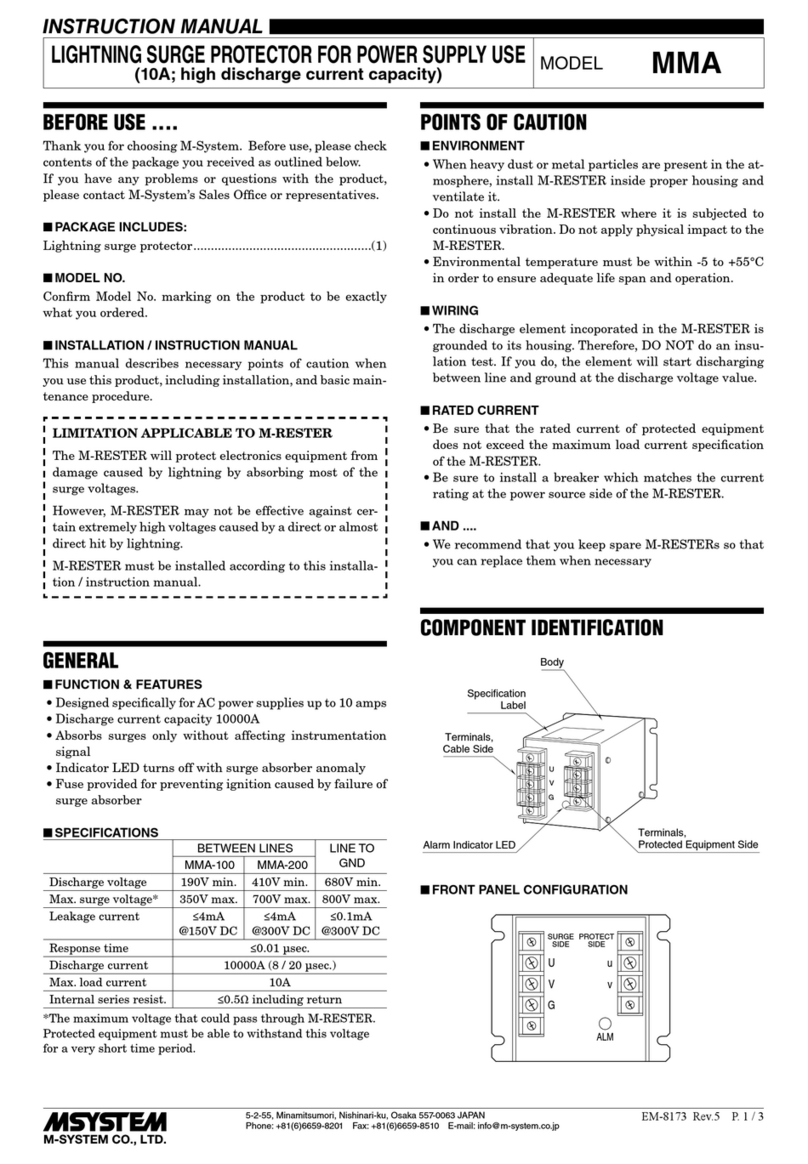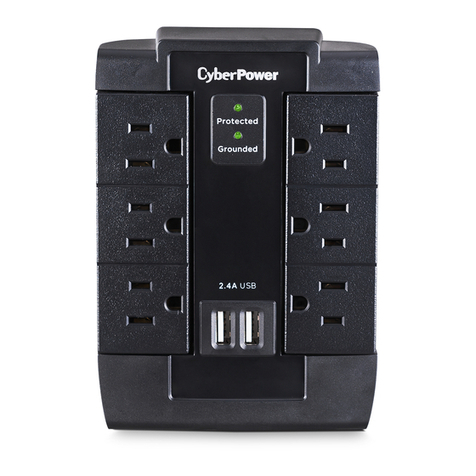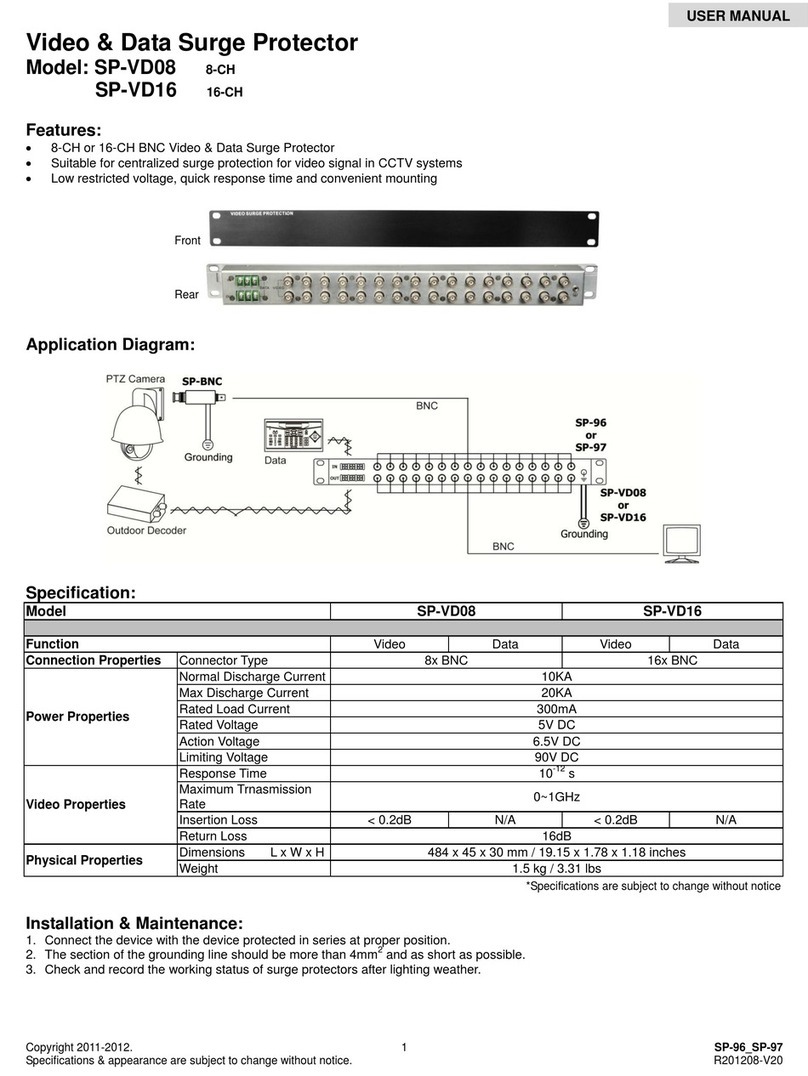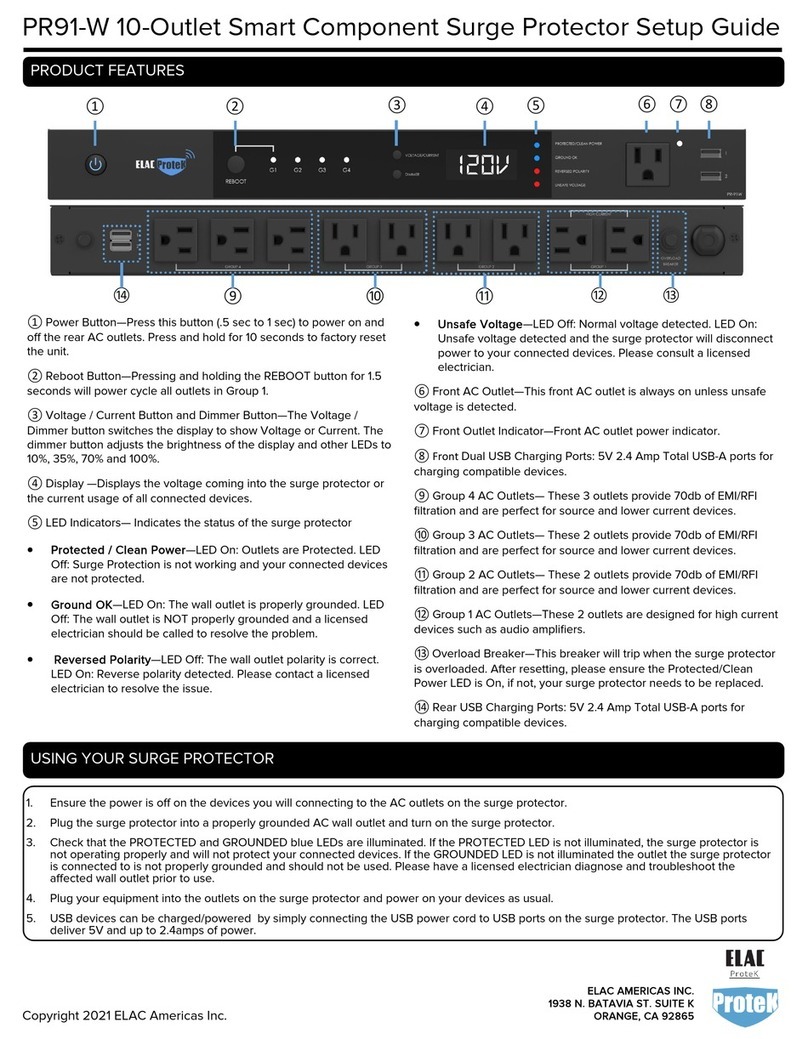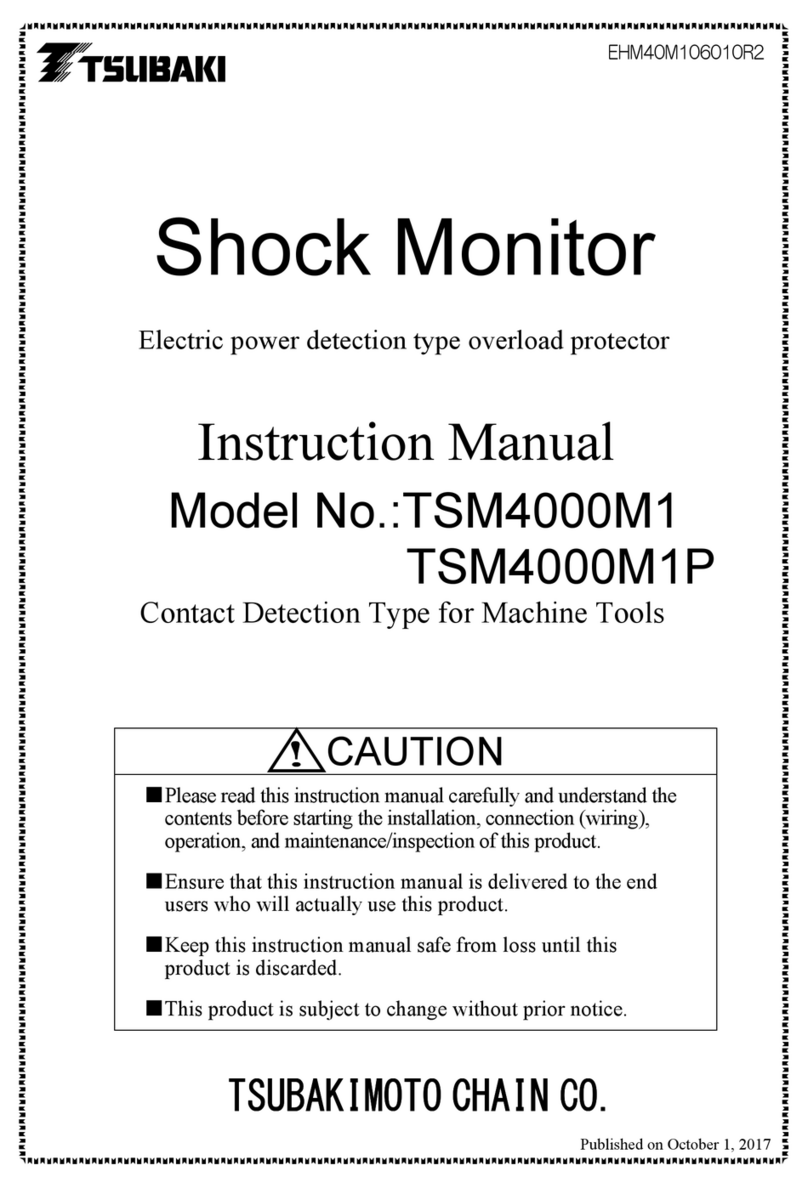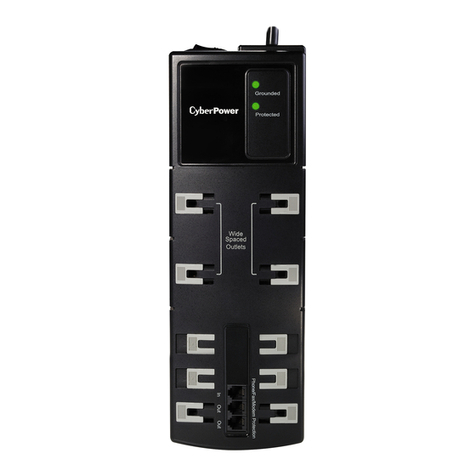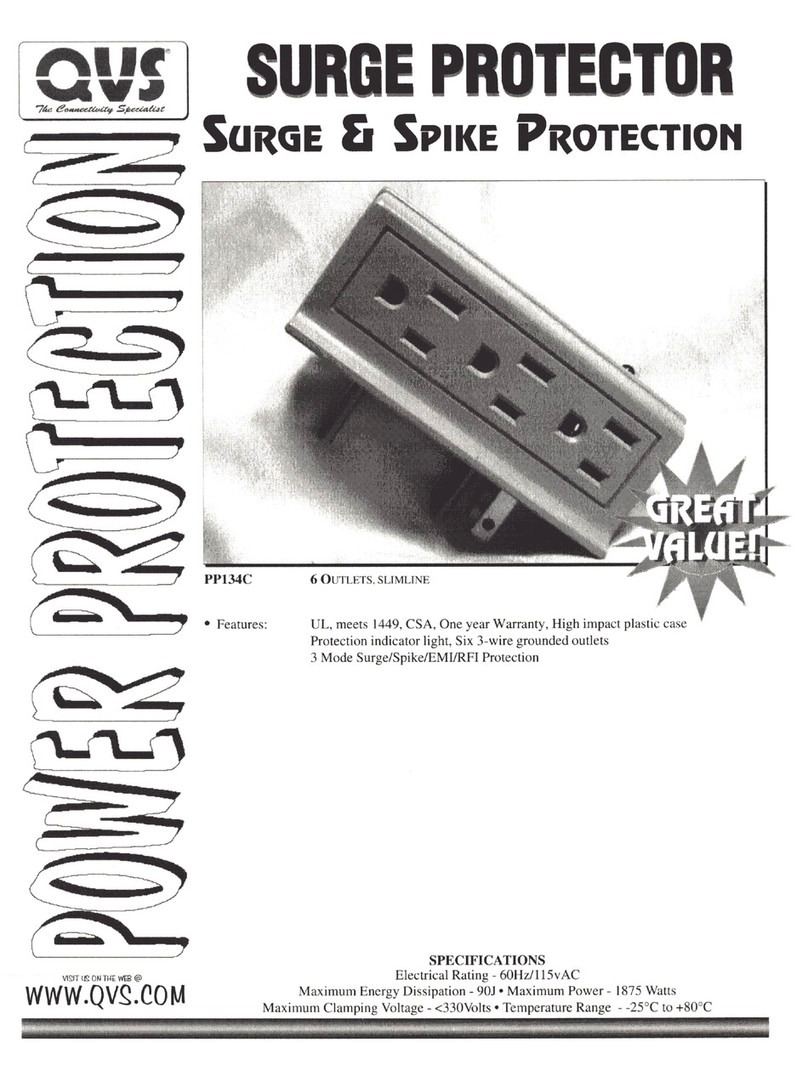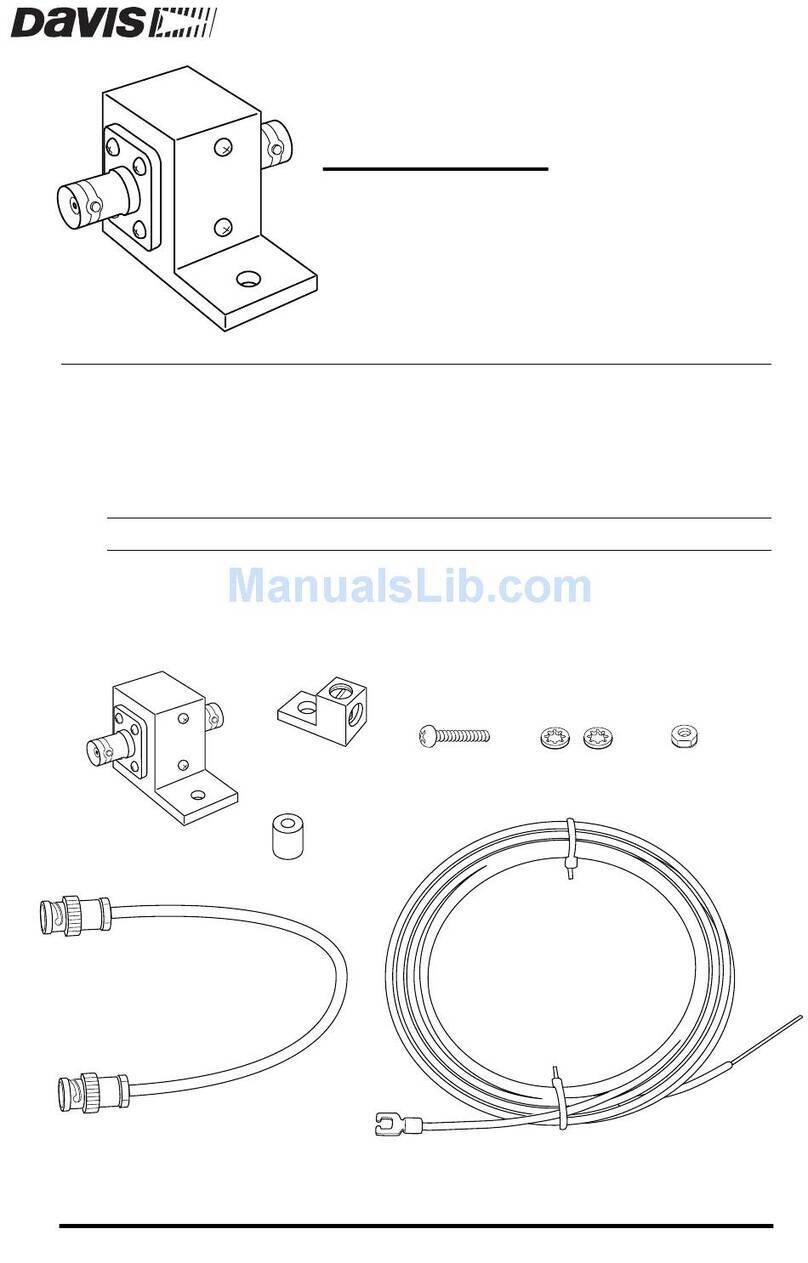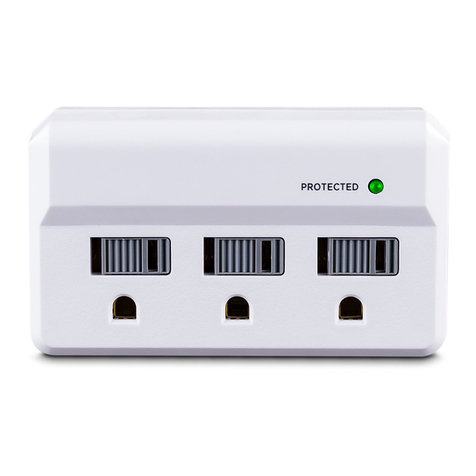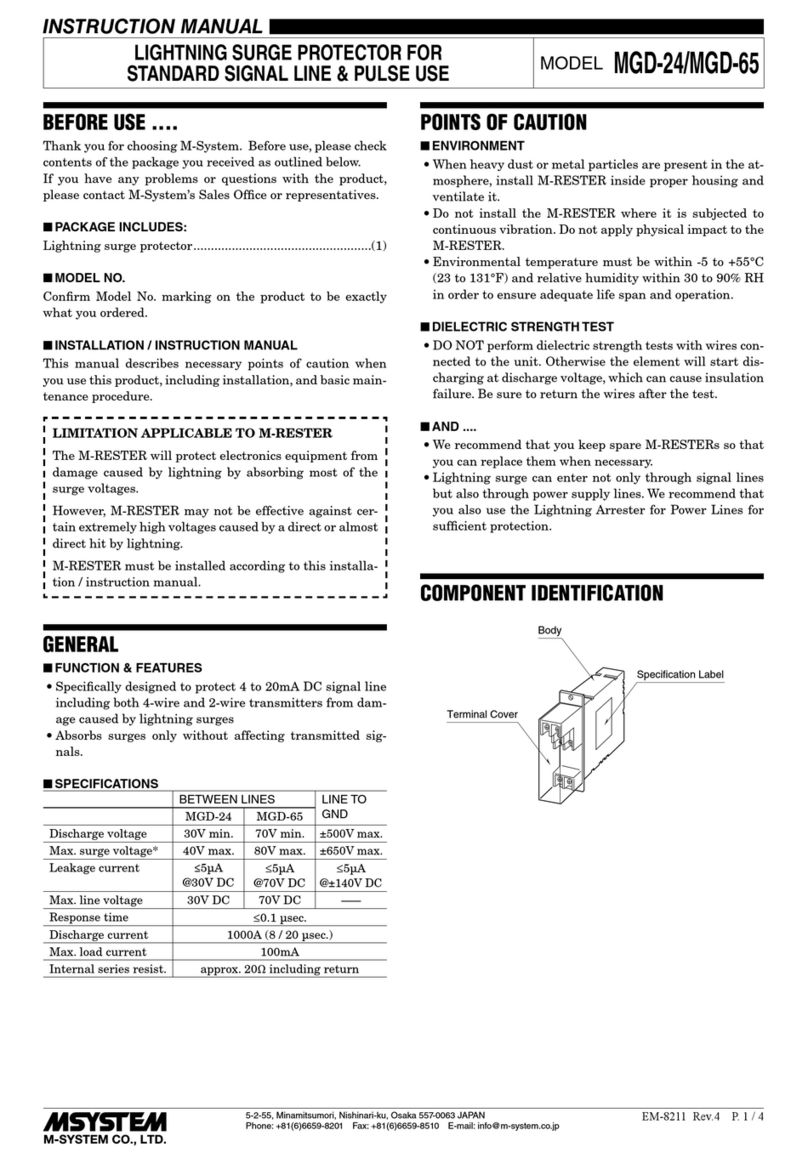
Modular DC
Surge Protective Device (SPD)
with Connection Terminal,
Connection Leads and Indicator Light
Cat. Nos. 3812, 3824, 3848
INSTALLATION INSTRUCTIONS
Protection contre les surtensions
Dispositif de limitation des surtensions
(DLS) modulaire pour circuits c.c. avec
borne, fils de raccordement et témoin
lumineux
Nos de cat. 3812, 3824 et 3848
DIRECTIVES D’INSTALLATION
Protector de Sobretensión Modular CD
con Terminal de Conexión, Conductores
de Conexión y Luz Indicadora
Nos. de Cat. 3812, 3824, 3848
INSTRUCCIONES DE INSTALACIÓN
ENGLISH
INTRODUCTION
Transient voltage surges are short-term deviations from a desired voltage level or signal that can occur at any time. Such changes can result in an
electronic device malfunction, or cause extensive damage. Also termed "spikes", these occurrences take place as a result of magnetic field/inductive
coupling or whenever the line current is interrupted. They can originate from either inside a facility, or derive from outside utility lines. Sources within a
facility involve loads that are switched, such as electric motors that are turned ON and OFF. Outside transient influences involve utility grid switching.
DESCRIPTION
Leviton DC SPDs (Surge Protective Devices) are intended for use with sensitive electronic equipment and appliances with solid state circuitry that would
benefit from protection against damage caused by transient surges.
SPECIFICATIONS
Maximum Surge Currents: 1kA
NOTE: The Strike Breakdown Voltage results for the 100V/Sec. are lower than the actual results for transient surge voltages. This is a controlled
environment safety test and does not represent results during transient conditions. The SPD does not degrade the DC system during normal operation.
GENERAL INFORMATION
•This device is intended for low voltage DC circuits ONLY.
•This device DOES NOT provide ground fault or overload protection.
•This device protects against surges at this module ONLY.
•The indicator light denotes surge suppression is effective when it is continuously ON.
•When the indicator light turns OFF, the device is no longer providing suppression due to damage caused by excessive transient voltage surges.
The entire unit must be replaced if surge suppression is required.
•Modules should be replaced as soon as possible after a failure is noted.
TO INSTALL
WARNING: TO BE INSTALLED AND/OR USED IN ACCORDANCE WITH APPROPRIATE ELECTRICAL CODES AND REGULATIONS.
WARNING: IF YOU ARE UNSURE ABOUT ANY PART OF THESE INSTRUCTIONS, CONTACT A QUALIFIED ELECTRICIAN.
WARNING: TO AVOID FIRE, SHOCK, OR DEATH; TURN OFF POWER AT CIRCUIT BREAKER OR FUSE AND TEST THAT THE POWER IS OFF
BEFORE WIRING.
WARNING: THIS DEVICE IS NOT A LIGHTNING ARRESTOR. IT WILL NOT SURVIVE LIGHTNING STRIKES IN CLOSE PROXIMITY TO THE
PREMISES.
WARNING: ELECTROCUTION, FATAL, OR SERIOUS INJURY AND PROPERTY/EQUIPMENT DAMAGE CAN RESULT FROM FAULTY
INSTALLATION AND/OR SERVICING. ALWAYS TURN POWER OFF BEFORE REPLACING MODULES.
WARNING: A TVSS MODULE IN A FEED-THROUGH BRANCH CIRCUIT WILL PROVIDE PROTECTION ONLY FOR LOADS WIRED DIRECTLY TO IT.
IT WILL NOT PROVIDE PROTECTION TO ANY OTHER MODULES ON THE SAME BRANCH CIRCUIT.
WARNING: VERIFY SYSTEM VOLTAGE IS CONSISTENT WITH SPD.
CAUTION: USE THIS DEVICE WITH COPPER OR COPPER CLAD WIRE. WITH ALUMINUM WIRE USE ONLY WITH DEVICES MARKED CO/ALR
OR CU/AL.
FOR DC SPD (OEM) INSTALLATION:
1. TURN OFF POWER.
2. Select mounting location for module.
3. Use a test lamp to confirm that the circuit is NOT powered.
4. Prepare mounting location by drilling 2 holes 3.28" (8.3 cm) apart.
5. Connect leads per appropriate WIRING DIAGRAM as follows: Cut RED (+) wire and strip insulation approx. 3/4" (1.9 cm) to expose bare copper.
Pigtail RED wire with RED lead. Cut BLACK (-) wire and strip insulation approx. 3/4" (1.9 cm) to expose bare copper wire. Pigtail BLACK wire with
BLACK lead.
6. Twist strands of each separate wire connection tightly together with circuit conductor and push firmly into appropriate wire connector. Screw
connectors on clockwise making sure that no bare wire shows below the wire connectors. Secure each wire connector with electrical tape.
7. Restore power at circuit breaker or fuse. INSTALLATION IS COMPLETE.
NOTE: The indicator light should be ON following the diagnostic check of the internal circuitry (less than 20 seconds). If it is NOT, consult a qualified
electrician.
FOR DC SPD (DIN and OWM) INSTALLATION:
1. TURN OFF POWER.
2. Select mounting location for module.
3. Use a test lamp to confirm that the circuit is NOT powered.
4. FOR 38XX-OWM: Prepare mounting location by drilling 2 holes 3.28" (8.3 cm) apart.
5. Connect leads per appropriate WIRING DIAGRAM as follows: Cut RED (+) wire and strip insulation approx. 3/4" (1.9 cm) to expose bare copper.
Pigtail together with a short length of RED insulated copper wire of the appropriate gauge. Secure the other end of the RED pigtail lead tightly in
terminal block located on top of the module labeled “+” with terminal block screws. Cut BLACK (-) wire and strip insulation. Pigtail together with a
short length of BLACK insulated copper wire of the appropriate gauge. Secure the other end of the BLACK pigtail lead tightly in terminal block
located on top of the module labeled “-” with terminal block screws.
6. Twist strands of each separate wire connection tightly together with circuit conductor and push firmly into appropriate wire connector. Screw connectors on
clockwise making sure that no bare wire shows below the wire connectors. Secure each wire connector with electrical tape.
7A. FOR 38XX-DIN: Engage the module mounting clip on the DIN rail. Push down until locked.
7B. FOR 38XX-0WM: Mount the device with mounting tabs in the location where the holes were drilled.
8. Restore power at circuit breaker or fuse. INSTALLATION IS COMPLETE.
NOTE: The indicator light should be ON following the diagnostic check of the internal circuitry (less than 20 seconds). If it is NOT, consult a qualified
electrician.
FRANÇAIS
INTRODUCTION
Les surtensions transitoires sont de courtes déviations du signal ou du niveau de tension qui peuvent se produire à tout moment. De telles
variations peuvent perturber le fonctionnement du matériel électronique ou provoquer des dommages importants. Aussi appelées crêtes, les
surtensions sont souvent causées par un champ magnétique, par un couplage inductif ou encore, par une interruption de courant. Elles peuvent
naître à l’intérieur d’une installation ou provenir d’une source externe. À l’interne, les surtensions peuvent être générées par la commutation de
charges, comme des moteurs électriques qui démarrent et qui s’arrêtent; à l’externe, elles peuvent être causées par de la commutation de réseaux
électriques.
DESCRIPTION
Les DLS (dispositifs limiteurs de surtensions) de Leviton pour circuits c.c. sont conçus pour protéger le délicat matériel électronique et les
appareils à semi-conducteurs contre les surtensions transitoires.
GRILLE TECHNIQUE
Courant transitoire maximal : 1kA
REMARQUE : les tensions d’amorçage de la colonne “100 V/s” sont moins élevées que celles observées sur le terrain; elles ont été produites dans
l’environnement contrôlé d’essais de sécurité et ne reflètent pas les valeurs qu’on peut atteindre en présence de véritables surtensions transitoires.
Les DLS n’endommagent pas les systèmes à courant continu lorsqu’ils exécutent leurs fonctions normales.
RENSEIGNEMENTS GÉNÉRAUX
•Ce dispositif est conçu pour les circuits c.c. à basse tension SEULEMENT.
•Ce dispositif ne protège pas contre les fuites à la terre ni contre les surcharges.
•Ce dispositif protège seulement le matériel auquel il est directement raccordé.
•Quand il est continuellement allumé, le témoin indique que le dispositif assure bel et bien une protection contre les surtensions.
•Quand il est éteint, le témoin indique que le module est endommagé et ne fait plus son travail en raison de surtensions trop élevées.
Le dispositif doit alors être remplacé.
•Les DLS doivent être remplacés sans délai lorsqu’ils ne fonctionnent plus.
INSTALLATION
AVERTISSEMENT : INSTALLER OU UTILISER CONFORMÉMENT AUX CODES DE L’ÉLECTRICITÉ EN VIGUEUR.
AVERTISSEMENT : À DÉFAUT DE BIEN COMPRENDRE LES DIRECTIVES SUIVANTES, EN TOUT OU EN PARTIE, ON DOIT FAIRE
APPEL À UN ÉLECTRICIEN QUALIFIÉ.
AVERTISSEMENT : POUR ÉVITER LES RISQUES D’INCENDIE, DE CHOC ÉLECTRIQUE OU D’ÉLECTROCUTION, COUPER LE COURANT AU
FUSIBLE OU AU DISJONCTEUR ET S’ASSURER QUE LE CIRCUIT SOIT BIEN COUPÉ AVANT DE PROCÉDER À L’INSTALLATION.
MISE EN GARDE : N’UTILISER CE DISPOSITIF QU’AVEC DU FIL DE CUIVRE; EN PRÉSENCE DE FIL D’ALUMINIUM, UTILISER
SEULEMENT LES DISPOSITIFS PORTANT LA MARQUE CU/AL OU CO/ALR.
AVERTISSEMENT : CE DISPOSITIF N’EST PAS UN PARAFOUDRE; IL NE RÉSISTERA PAS AUX COUPS DE FOUDRE À PROXIMITÉ DES
INSTALLATIONS.
AVERTISSEMENT : À DÉFAUT D’INSTALLER OU D’ENTRETENIR CORRECTEMENT CE DISPOSITIF, ON RISQUE D’ENDOMMAGER LE
MATÉRIEL Y ÉTANT RACCORDÉ, DE SE BLESSER GRAVEMENT OU D’ÊTRE ÉLECTROCUTÉ; ON DOIT TOUJOURS COUPER LE
COURANT AVANT DE REMPLACER UN MODULE.
AVERTISSEMENT : UN DLS INSTALLÉ DANS UNE DÉRIVATION COMMUNE NE PROTÈGE QUE LES CHARGES QUI LUI SONT
DIRECTEMENT RACCORDÉES; IL N’OFFRE AUCUNE PROTECTION AUX AUTRES CHARGES DE LA DÉRIVATION.
AVERTISSEMENT : S’ASSURER QUE LA TENSION DU CIRCUIT CORRESPONDE AUX VALEURS NOMINALES DU DISPOSITIF.
DIRECTIVES D’INSTALLATION DES DISPOSITIFS “OEM” :
1. COUPER LE COURANT.
2. Déterminer l’emplacement du module.
3. Au moyen d’une lampe de vérification, s’assurer que le circuit ne soit pas alimenté.
4. Préparer la surface d’installation en y perçant deux orifices à 8,3 cm (3,28 po) l’un de l’autre.
5. Raccorder les fils conformément au SCHÉMA DE CÂBLAGE approprié et de la façon suivante : couper le fil ROUGE (+) et le dénuder sur
environ 1,9 cm (0,75 po) de manière à exposer les brins de cuivre. Le torsader avec le fil de sortie ROUGE. Couper le fil NOIR (-) et le
dénuder sur environ 1,9 cm (0,75 po) de manière à exposer les brins de cuivre. Le torsader avec le fil de sortie NOIR.
6. Torsader solidement ensemble les brins de chaque raccord et enfoncer le tout fermement dans un serre-fils de calibre approprié, en tournant ce
dernier vers la droite et en s’assurant qu’aucun brin de cuivre ne dépasse. Protéger les raccords au moyen de ruban isolant.
7. Rétablir le courant au fusible ou au disjoncteur; L’INSTALLATION EST TERMINÉE.
REMARQUE : le témoin devrait s’allumer après un délai maximal de 20 secondes pour permettre une auto-vérification des circuits. S’il ne l’est
PAS, faire appel à un électricien qualifié.
DIRECTIVES D’INSTALLATION DES DISPOSITIFS “DIN” ET “OWM” :
1. COUPER LE COURANT.
2. Déterminer l’emplacement du module.
3. Au moyen d’une lampe de vérification, s’assurer que le circuit ne soit pas alimenté.
4. MODÈLES 38XX-OWM : Préparer la surface d’installation en y perçant deux orifices à 8,3 cm (3,28 po) l’un de l’autre.
5. Raccorder les fils conformément au SCHÉMA DE CÂBLAGE approprié et de la façon suivante : couper le fil ROUGE (+) et le dénuder sur
environ 1,9 cm (0,75 po) de manière à exposer les brins de cuivre. Le torsader avec une courte longueur de fil ROUGE de calibre approprié.
Raccorder solidement l’autre extrémité de ce dernier à la borne marquée d’un “+” sur le dessus du module. Couper et dénuder le fil NOIR (-).
Le torsader avec une courte longueur de fil NOIR de calibre approprié. Raccorder solidement l’autre extrémité de ce dernier à la borne
marquée d’un “-” sur le dessus du module.
6. Torsader solidement ensemble les brins de chaque raccord et enfoncer le tout fermement dans un serre-fils de calibre approprié, en tournant ce
dernier vers la droite et en s’assurant qu’aucun brin de cuivre ne dépasse. Protéger les raccords au moyen de ruban isolant.
7A. MODÈLES 38XX-DIN : Engager l’agrafe de fixation dans le rail “DIN”. Appuyer jusqu’à ce qu’il s’enclenche.
7B. MODÈLES 38XX-OWM : Fixer le dispositif au moyen des pattes de montage en utilisant les orifices pratiqués.
8. Rétablir le courant au fusible ou au disjoncteur; L’INSTALLATION EST TERMINÉE.
REMARQUE : le témoin devrait s’allumer après un délai maximal de 20 secondes pour permettre une auto-vérification des circuits. S’il ne
l’est PAS, faire appel à un électricien qualifié.
PK-92556-10-02-0A
PK-92556-10-02-0A
LIMITED 5 YEAR WARRANTY AND EXCLUSIONS
Leviton warrants to the original consumer purchaser and
not for the benefit of anyone else that this product at the
timeofitssalebyLevitonisfreeofdefectsinmaterialsand
workmanship under normal and proper use for five years
from the purchase date. Leviton’s only obligation is to
correctsuchdefectsbyrepairorreplacement,atitsoption,
if within such five year period the product is returned
prepaid, with proof of purchase date, and a description of
the problem to Leviton Manufacturing Co., Inc., Att:
Quality Assurance Department, 59-25 Little Neck
Parkway, Little Neck, New York 11362-2591. This
warrantyexcludesandthere isdisclaimedliabilityforlabor
for removal of this product or reinstallation. This warranty
is void if this product is installed improperly or in an
improper environment, overloaded, misused, opened,
abused, or altered in any manner, or is not used under
normaloperating conditionsor notin accordancewith any
labels or instructions. There are no other or implied
warrantiesofanykind,includingmerchantabilityandfitness
for a particular purpose, but if any implied warranty is
required by the applicable jurisdiction, the duration of any
suchimpliedwarranty,includingmerchantabilityandfitness
for a particular purpose, is limited to five years. Leviton is
not liable for incidental, indirect, special, or consequential
damages, including without limitation, damage to, or loss
of use of, any equipment, lost sales or profits or delay or
failure to perform this warranty obligation. The remedies
provided herein are the exclusive remedies under this
warranty, whether based on contract, tort or otherwise.
For Technical Assistance Call:
1-800-824-3005 (U.S.A. Only)
www.leviton.com
3812-DIN
3824-DIN
3848-DIN
3812-OWM
3824-OWM
3848-OWM
3812-OEM
3824-OEM
3848-OEM
12 V c.c.
24 V c.c.
48 V c.c.
SPD Catalog Numbers Nominal Voltages Strike Breakdown Voltages
100 V/µs
14.7 á 19.8 V
33.1 á 38.2 V
51.8 á 71.8 V
100 V/s
9.4 á 11.6 V
18.2 á 19.2 V
24.0 á 28.0 V 3812-DIN
3824-DIN
3848-DIN
3812-OWM
3824-OWM
3848-OWM
3812-OEM
3824-OEM
3848-OEM
12 V c.c.
24 V c.c.
48 V c.c.
Numéros de catalogue des DLS Tensions nominales Surtensions d'amorçage
100 V/µs
14.7 á 19.8 V
33.1 á 38.2 V
51.8 á 71.8 V
100 V/s
9.4 á 11.6 V
18.2 á 19.2 V
24.0 á 28.0 V

